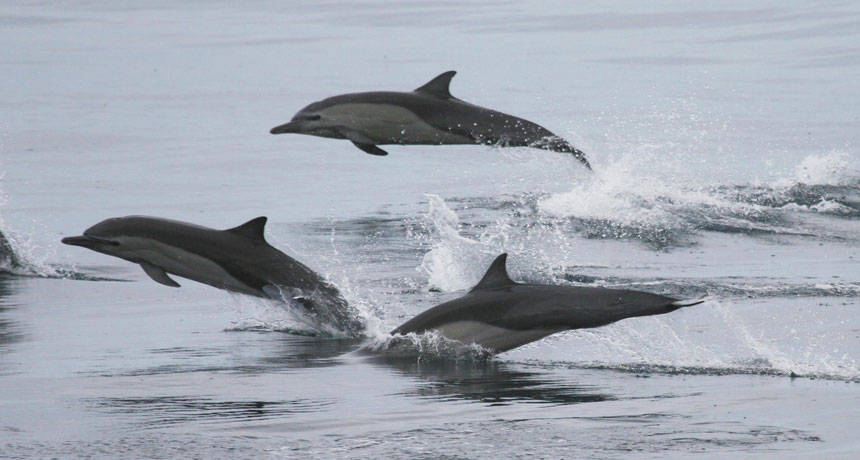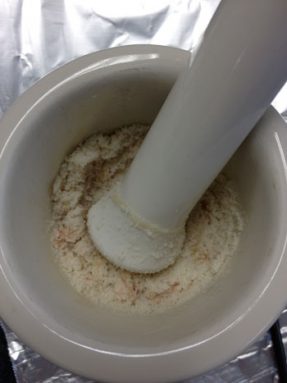Using dolphins to find unknown ocean pollutants
Scientists sample the animals’ fatty blubber then test it for evidence of toxic pollutants

A pod of short-beaked common dolphins. These marine mammals live about 35 years, giving them plenty of time to build up ocean pollutants in their blubber. A new method helps find the hidden pollutants that could pose a risk to dolphins — and human health.
Southwest Fisheries Science Center/ NOAA Fisheries
By Liz Devitt
SAN FRANCISCO, Calif. — Marisa Trego is trying to solve a riddle. The marine biologist wants to find long-lasting ocean pollutants that no one knows about — yet. They could be toxic, causing health problems in wildlife and people. She studies dolphins to find clues about these pollutants. But when you don’t know what you’re looking for, how can you find it? Trego’s solution: Look in fat.
When she did, using a new approach, she found more than 30 percent of the test samples held pollutants that no one could name.
Trego works at the Conservation Ecology Lab at San Diego State University in California. She reported her team’s early findings on December 14, at the Society for Marine Mammalogy meeting in San Francisco.
Her team has been studying insulating fatty tissue, known as blubber. It’s what keeps most marine mammals warm. Many long-lived — or persistent — pollutants tend to accumulate in fat (whether that fat is in a whale, a dolphin, an insect or a person). And the longer an animal lives, the longer its fat has to pick up these pollutants. This buildup is called bioaccumulation. That’s why scientists often test small samples of blubber for specific chemicals, such as DDT (an insect-killing chemical that was banned most places years ago).
But probing samples for what you think they may contain — or what’s easy to measure — isn’t always helpful, says Trego. It “doesn’t really give you the whole picture” of what pollutants may be there, she explains. So she uses a combination of tests. These don’t look for particular chemicals. “This newer method lets the sample tell you what’s in it,” she explains.
Trego collected blubber samples from 10 short-beaked common dolphins (Delphinus delphis). Then she used the new tests to analyze what was in the fat. She’s especially interested in finding pollutants known as halogenated (HAY-lo-jen-ait-ed) compounds, or HOCs. Chemicals that include halogens are known for lasting a long time and building up in fat. HOCs also are very likely to be toxic.
Eunha Hoh is a scientist at San Diego State University in California. She focuses on environmental health issues. And she developed the new method that Trego’s team has just used.
Hoh took small pieces of blubber from bottlenose dolphins (Tursiops truncatus) and analyzed them using two different instruments. Each sample generated up to 10,000 chemical “fingerprints.” These were the distinct signatures of different compounds. Then, Hoh picked out the fingerprints that shared some similarities to known HOCs. With a shorter list of about 100 to 200 “suspects,” she worked on finding the true identity of the pollutants in the blubber.
Getting an ID was like trying to catch a criminal by searching police records for matching human fingerprints. To find matches for unknown compounds, Hoh looked through databases of chemical “fingerprints.” Some pollutants have no fingerprints on file. Those “suspects” may stay listed as unknown for a little longer.
One of Trego’s goals is to speed up this fingerprint-matching process. So far, Hoh has compiled a library of 327 known chemicals. Using that library, Trego identified 7 out of every 10 of the compounds in her samples. These included DDT and other insecticides. Still, many compounds remain unidentified. “That shows we have a lot more to learn,” Trego says. If she can add new IDs to the library, that will help other researchers, too.
Unhealthy connections

Later, Trego will study skin samples. From those, she hopes to coax out the DNA to see which genes were turned “on” or “off” at the time the sample was collected. These patterns, too, can provide clues to an animal’s health.
“Putting all these things together will give us a big picture of what’s going on with the dolphins,” says Trego. Their overall health is important. If there are toxic pollutants in the sea, these can act as sentinels. That means that these animals can point to possible health risks in other animals, including people.
“We have a lot of new technologies. Using them just to find new pollutants isn’t enough,” says Karen Acevedo-Whitehouse. She is a veterinarian who works with marine mammals at the Autonomous University of Queretaro, in Mexico. “We need to link these findings to the health of oceans, animals and people,” she explains. “Without that connection, none of it makes sense.”
Power Words
(for more about Power Words, click here)
bioaccumulation A term for the body’s process of picking up substances (usually from the environment) and then storing them within tissues (such as fat) in ever-growing quantities.
blubber The thick layer of fat under a marine mammal’s skin that helps it stay warm even in cold waters. In the past, whalers would boil whale blubber to extract oil, which had many industrial uses.
compound (often used as a synonym for chemical) A compound is a substance formed from two or more chemical elements united in fixed proportions. For example, water is a compound made of two hydrogen atoms bonded to one oxygen atom. Its chemical symbol is H2O.
contaminant Pollutant; a chemical, biological or other substance that is unwanted or unnatural in an environment such as water, soil, air, or food. Some contaminants may be harmful in the amounts at which they occur or if they are allowed to build up in the body over time.
cortisol A stress hormone that helps release glucose into the blood in preparation for the fight or flight response.
DDT (short for dichlorodiphenyltrichloroethane) This toxic chemical was for a time widely used as an insect-killing agent. It proved so effective that Swiss chemist Paul Müller received the 1948 Nobel Prize (for physiology or medicine) just eight years after establishing the chemical’s incredible effectiveness in killing bugs. But many developed countries, including the United States, eventually banned its use for its poisoning of non-targeted wildlife, such as birds.
DNA (short for deoxyribonucleic acid) A long, double-stranded and spiral-shaped molecule inside most living cells that carries genetic instructions. It is built on a backbone of phosphorus, oxygen, and carbon atoms.In all living things, from plants and animals to microbes, these instructions tell cells which molecules to make.
environmental health A research field that focuses on measuring the effects of pollutants and other factors in the environment on the health of people, wildlife or ecosystems.
gene A segment of DNA that codes, or holds instructions, for producing a protein. Offspring inherit genes from their parents. Genes influence how an organism looks and behaves.
halogen An element from a row on the periodic table that includes fluorine, chlorine, bromine, iodine and astatine. These nonmetallic elements are reactive, so they combine with hydrogen to form strong acids. Compounds made with these elements are often referred to as halogenated. They also may resist breakdown in the environment. Such chemicals are referred to as persistent.
halogenated organic compounds (HOCs) Carbon-based compounds that contain one (or more) of the five elements in the halogen group: fluorine, chlorine, bromine, iodine, or astatine. Many are toxic because these compounds are very reactive. That is, HOCs quickly combine with other chemicals to form new — and usually harmful — compounds. HOCs are used in medicines, plastics, paint, cars and flame-resistant coatings. They last in the environment for a long time. And if those compounds are toxic, that can be a bad thing. Consider DDT (dichlorodiphenyltrichloroethane). The United States banned this insecticide in 1972 because of its poisonous effects on animals and people — and the fact that it resisted breakdown once it got into the environment (thereby persisting for decades). It’s important to note that not all HOCs are bad. Marine algae also make these compounds. Scientists aren’t yet sure if the natural compounds can be toxic, too.
hormone (in zoology and medicine) A chemical produced in a gland and then carried in the bloodstream to another part of the body. Hormones control many important body activities, such as growth. Hormones act by triggering or regulating chemical reactions in the body.
insecticide A substance used to kill insects.
marine biology The field of science that deals with studying creatures that live in ocean water, from bacteria and shellfish to kelp and whales. A person who works in this field is called a marine biologist.
persistent An adjective for something that is long-lasting.
pesticide A chemical or mix of compounds used to kill insects, rodents or other organisms harmful to cultivated plants, pet or livestock, or unwanted organisms that infest homes, offices, farm buildings and other protected structures.
pollutant A substance that taints something — such as the air, water, our bodies or products. Some pollutants are chemicals, such as pesticides. Others may be radiation, including excess heat or light. Even weeds and other invasive species can be considered a type of biological pollution.
polychlorinated biphenyls (or PCBs) A family of 209 chlorine-based compounds with a similar chemical structure. They were used for many decades as a nonflammable fluid for insulating electrical transforms. Some companies also used them in making certain hydraulic fluids, lubricants and inks. Their production has been banned in North America and many countries throughout the world since around 1980.
sentinel A guard or something that watches over others, or that effectively offers some warning of a potential problem.
testosterone Although known as a male sex hormone, females make this reproductive hormone as well (generally in smaller quantities). It gets its name from a combination of testis (the primary organ that makes it in males) and sterol, a term for some hormones. High concentrations of this hormone contribute to the greater size, musculature and aggressiveness typical of the males in many species (including humans).
toxic Poisonous or able to harm or kill cells, tissues or whole organisms. The measure of risk posed by such a poison is its toxicity.
veterinary Having to do with animal health. A doctor who specializes in treating animals is a veterinarian.







